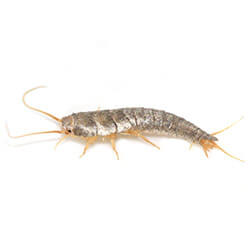Identification
- Colour Brown, grey, silver
- Size From 12 mm to 15 mm long
- Description Wingless insects shaped like a teardrop. Their bodies are flattened, tapered at the rear, and covered with shiny, fish-like scales.

Where do silverfish live?
Notably elusive, silverfish are nocturnal creatures that move swiftly when disturbed to escape detection. Silverfish prefer dark, moist environments with humidity levels between 75 and 95 percent. Outdoors, silverfish primarily live under rocks, leaf mold, and tree bark. In residential buildings, common silverfish habitats include basements, bathrooms, kitchens, and attics. The insects often inhabit the cracks and crevices of walls and floors. Normally capable of moving at rapid speeds, silverfish lack the ability to climb smooth surfaces.
How long do silverfish bugs live?
For silverfish, the reproductive process begins with an elaborate mating ritual performed between males and females. At the conclusion of the ritual, male silverfish deposit a sperm capsule that the female absorbs for fertilization. Female silverfish lay their eggs, often in small groups, within tiny cracks and crevices. The eggs typically hatch in three to six weeks. Newly hatched silverfish look like miniature adult silverfish and acquire the distinctive shiny appearance of adults within 40 days. The average female silverfish will lay up to 100 eggs during her life. Silverfish have a lifespan ranging from two to eight years.
What do silverfish eat?
Silverfish are generally scavenger feeders that will eat virtually anything available. The insects, however, prefer to feed on carbohydrates and proteins. Within their natural habitat outdoors, silverfish mainly consume vegetable matter. Silverfish living among humans often eat common household items and frequently invade kitchen pantries. Despite their established dietary preferences, silverfish can survive without food for up to a year.
Why do I have silverfish?
Silverfish prefer dark, moist environments with humidity levels above 75%. Outdoors, silverfish like to live under rocks, leaf mould, and tree bark. In homes, silverfish live in cracks and crevices in basements, bathrooms, kitchens, and attics.
These pests are scavengers that will eat virtually anything available, especially carbohydrates and proteins. Outdoors, they consume vegetable matter, but once indoors, they will feed on flour, dried meat, glue, wallpaper, cereal, rolled oats, and other starches.
How worried should I be about silverfish?
Silverfish can contaminate food, stain clothing, destroy books, and are generally a maddening presence in the home.
Silverfish have a slow reproduction rate but can survive without food for a year, with a lifespan of up to eight years. If you have a silverfish infestation, it is a sign of a long-term problem that requires the help of a professional pest control service.
How can I prevent silverfish invading?
Keep rooms cool, clean, and dry, Vacuum cracks and crevices frequently, Use dehumidifiers to lower humidity, Remove old papers, boxes, books, and clothes
Other pests related to Silverfish
100% Satisfaction or Money Back Guarantee
Resolving your pest problem is our #1 priority. If re-treatment is required, we'll provide immediate services at no extra cost. If your expectations are not met, we guarantee a full refund of your service payment.
Remove pests from your home, and stop them from coming back
We work hard to listen, understand and assess your unique situation. Request a free, no-obligation estimate today for a customized pest program that fits your needs.
Request a Free Home EstimateRequest a Free Business Consultation

